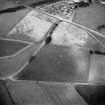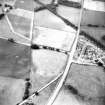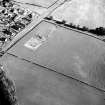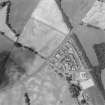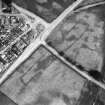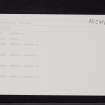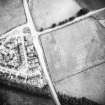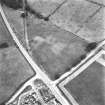Pricing Change
New pricing for orders of material from this site will come into place shortly. Charges for supply of digital images, digitisation on demand, prints and licensing will be altered.
Holywood South
Cursus (Neolithic)
Site Name Holywood South
Classification Cursus (Neolithic)
Alternative Name(s) Newbridge Cursus; Holywood 1; Holywood Parish Church; New Bridge
Canmore ID 65652
Site Number NX97NW 23
NGR NX 94890 79660
NGR Description NX 9493 7951 to NX 94850 79790
Datum OSGB36 - NGR
Permalink http://canmore.org.uk/site/65652
First 100 images shown. See the Collections panel (below) for a link to all digital images.
- Council Dumfries And Galloway
- Parish Holywood
- Former Region Dumfries And Galloway
- Former District Nithsdale
- Former County Dumfries-shire
Holywood South Cursus is a long rectangular ditched enclosure dating from the early Neolithic period, which is thought to have had a ceremonial function. It measures 285m in length by approximately 35m in width, narrowing at the northern end. It is one of over thirty such monuments known in Scotland, and is part of a complex of monuments in the area that includes a second cursus, a stone circle, ring-ditches, enclosures and mounds.
Information from RCAHMS (SC) 1 August 2007
NX97NW 23 94930 79510 to 94850 79790
See also NX97NW 38, NX97NW 44, NX97NW 45.
Not to be confused with Holywood North cursus (NX 949 799 to NX 950 802), for which see NX98SE 42: this extends onto map sheets and NX97NW.
NX 949 797. Cursus 1 (possible), Holywood: visible on air photographs.
B Jones 1979
NX 949 795. New Bridge - Cursus. Visible on air photographs taken by G D B Jones. Copies of these photographs are lodged in Dumfries Museum.
Information from letter from B Jones to G Maxwell, RCAHMS, 4 July 1980.
(Location amended to NX 9493 7951 to 9485 7979). Nothing can now be seen of this cursus monument, which was first discovered by aerial photography. It lies on a terrace below the E edge of a broad gravel plateau immediately to the W of the A76 between Newbridge and Holywood. The cursus has square terminals and is defined by a broad ditch, which is broken by causeways at several points along its sides. It measures about 285m from NNW to SSE by 35m transversely, but narrows to about 22m towards its N end, where it appears to terminate on a slightly higher part of the terrace. It is plotted as a cursus monument on a distribution map of Neolithic monuments covering southern Scotland.
A ring ditch and a possible circular enclosure are enclosed by the cursus: the former measures about 11m in diameter and lies towards the N end, at a break through the E side of the cursus ditch (NX97NW 38); the latter is about 20m in diameter and lies within the SW corner of the S terminal (NX97NW 44). Two pits are also visible within the enclosure. A ring of elongated pits is situated to the W of the cursus immediately outside the northerly of the two entrance causeways through the W side near its S terminal (NX97NW 45).
Information from RCAHMS (ARG), 7 April 1998
RCAHMS 1997.
NX 951 802; NX 948 797 The Holywood cursus complex lies to the NW of Dumfries, and represents an important concentration of Neolithic field monuments. It is composed of two cursus monuments and a stone circle, the Twelve Apostles. There are also a number of minor features, which may represent ring-ditches, small enclosures, or ploughed-out mounds. Of the two cursuses, the southern example had squared terminals (NX97NW 23), while the northern one had rounded terminals (NX98SE 42). This difference in morphology may have chronological implications. Excavation in 1997 was intended to test the preservation of the monuments in the face of animal and agricultural damage over a very long period. As such, it was conceived as a sampling exercise. Large areas were opened to provide an extensive plan view of the monuments, but the total excavation of the features revealed was not contemplated. Rather, a number of features were selected, with the aim of acquiring representative sections, and samples for radiocarbon and environmental analysis.
At the northern cursus (NX98SE 42) , a cutting 60 x 40m in extent was opened over the northern terminal, while a smaller area was excavated to the S, in order to investigate an entrance in the side of the monuments. The cursus ditch was sectioned in six places, and in each case the basic sequence was one of a brief silting from the edge of the ditch, followed by a massive collapse of gravel, presumably from an internal bank, and above this a fine silting, which may have accumulated in a small recut in the top of the ditch. In the two cuttings on the eastern side of the cursus, the recut fills were sealed beneath a layer of iron pan, and this and the layer of degraded sandstone fragments above it rested on an unconformity with the earlier layers. Seemingly, a horizon of erosion preceded the renewed filling of the ditch, which may have been associated with a ploughing of the site. Numerous cut features lay within the circuit of the cursus ditch, most of these representing large post-holes. In some cases the remains of burnt posts remained, and sherds of earlier Neolithic pottery were recovered from a number of post-holes. It is likely that these posts represent a revetment for a gravel bank, which explains its catastrophic collapse into the ditch.
In contrast, the southern cursus (NX97NW 23) produced no evidence for bank revetment. Here a cutting 45 x 40m was opened, again over the northern terminal. A dump bank seemingly eroded slowly back into the U-shaped ditch. Such a bank must have covered a group of pits enclosed within the terminal of the cursus, which presumably pre-dated the monument. These contained complex fillings, much burnt material and earlier Neolithic pottery. A ring-ditch enclosed within the cursus was perhaps later in date, although it produced no dating evidence on excavation.
Geophysical survey was undertaken at the Twelve Apostles stone circle (NX97NW 19). This produced no indication of cut features within the circuit of the stones.
Sponsor: Historic Scotland
J Thomas 1998
Scheduled as 'Holywood, cursus, 1250m SSE of'.
Information from Historic Scotland, scheduling document dated 8 September 2003.
Aerial Photographic Interpretation (1979)
NX 949 797. Cursus 1 (possible), Holywood: visible on air photographs.
B Jones 1979
Aerial Photographic Transcription (15 January 1990 - 12 December 1990)
An aerial transcription was produced from oblique aerial photographs. Information from Historic Environment Scotland (BM) 31 March 2017.
Aerial Photographic Transcription (1991)
Aerial Photographic Transcription (1991)
Field Visit (7 April 1998)
(Location amended to NX 9493 7951 to 9485 7979). Nothing can now be seen of this cursus monument, which was first discovered by aerial photography. It lies on a terrace below the E edge of a broad gravel plateau immediately to the W of the A76 between Newbridge and Holywood. The cursus has square terminals and is defined by a broad ditch, which is broken by causeways at several points along its sides. It measures about 285m from NNW to SSE by 35m transversely, but narrows to about 22m towards its N end, where it appears to terminate on a slightly higher part of the terrace. It is plotted as a cursus monument on a distribution map of Neolithic monuments covering southern Scotland.
A ring ditch and a possible circular enclosure are enclosed by the cursus: the former measures about 11m in diameter and lies towards the N end, at a break through the E side of the cursus ditch (NX97NW 38); the latter is about 20m in diameter and lies within the SW corner of the S terminal (NX97NW 44). Two pits are also visible within the enclosure. A ring of elongated pits is situated to the W of the cursus immediately outside the northerly of the two entrance causeways through the W side near its S terminal (NX97NW 45).
Information from RCAHMS (ARG), 7 April 1998
Excavation (1998)
NX 951 802; NX 948 797 The Holywood cursus complex lies to the NW of Dumfries, and represents an important concentration of Neolithic field monuments. It is composed of two cursus monuments and a stone circle, the Twelve Apostles. There are also a number of minor features, which may represent ring-ditches, small enclosures, or ploughed-out mounds. Of the two cursuses, the southern example had squared terminals (NX97NW 23), while the northern one had rounded terminals (NX98SE 42). This difference in morphology may have chronological implications. Excavation in 1997 was intended to test the preservation of the monuments in the face of animal and agricultural damage over a very long period. As such, it was conceived as a sampling exercise. Large areas were opened to provide an extensive plan view of the monuments, but the total excavation of the features revealed was not contemplated. Rather, a number of features were selected, with the aim of acquiring representative sections, and samples for radiocarbon and environmental analysis.
At the northern cursus (NX98SE 42) , a cutting 60 x 40m in extent was opened over the northern terminal, while a smaller area was excavated to the S, in order to investigate an entrance in the side of the monuments. The cursus ditch was sectioned in six places, and in each case the basic sequence was one of a brief silting from the edge of the ditch, followed by a massive collapse of gravel, presumably from an internal bank, and above this a fine silting, which may have accumulated in a small recut in the top of the ditch. In the two cuttings on the eastern side of the cursus, the recut fills were sealed beneath a layer of iron pan, and this and the layer of degraded sandstone fragments above it rested on an unconformity with the earlier layers. Seemingly, a horizon of erosion preceded the renewed filling of the ditch, which may have been associated with a ploughing of the site. Numerous cut features lay within the circuit of the cursus ditch, most of these representing large post-holes. In some cases the remains of burnt posts remained, and sherds of earlier Neolithic pottery were recovered from a number of post-holes. It is likely that these posts represent a revetment for a gravel bank, which explains its catastrophic collapse into the ditch.
In contrast, the southern cursus (NX97NW 23) produced no evidence for bank revetment. Here a cutting 45 x 40m was opened, again over the northern terminal. A dump bank seemingly eroded slowly back into the U-shaped ditch. Such a bank must have covered a group of pits enclosed within the terminal of the cursus, which presumably pre-dated the monument. These contained complex fillings, much burnt material and earlier Neolithic pottery. A ring-ditch enclosed within the cursus was perhaps later in date, although it produced no dating evidence on excavation.
Geophysical survey was undertaken at the Twelve Apostles stone circle (NX97NW 19). This produced no indication of cut features within the circuit of the stones.
Sponsor: Historic Scotland
J Thomas 1998
Note (January 2017)
Enclosing space
From the beginning of the Neolithic period communities built monuments which enclosed space on a scale never before seen in Scotland. Amongst the earliest and largest are cursus monuments, so-called because when first identified in the 18th century they were thought to be Roman chariot racing arenas. It was not until the 20th century that excavation and dating showed them to be of Neolithic date. So what are these strange named monuments? Well, cursus monuments are long linear enclosures, often measuring up to several hundred metres in length, which were built of large timber posts or a ditch and bank. Although we group them all under the one name ‘cursus’ the different materials (timber and stone) represent two distinctly different, though probably related, forms of monument built at different times during the Neolithic period. Those built of timber posts were constructed during the earliest centuries of the Neolithic, probably between 3900 and 3600 BC, while earthwork (or ditch and bank) cursus monuments were built slightly later, between around 3600-3000 BC. Intriguingly wooden cursus monuments, the earliest dated cursus form, have been found only in Scotland while the others were built throughout the whole the British Isles. So, as far as we know at present, timber cursus monuments are a uniquely Scottish phenomenon.
Impressive monuments
As a whole cursus monuments are largely to be found in the east and south of Scotland. The upstanding elements of most have long gone, either decayed and disappeared or been levelled out by repeated ploughing. We are able to identify these monuments through cropmarks recognised and photographed through aerial survey, the colours and patterns in crops showing the outline of post-holes or ditches defining these large enclosures. Examples include a large timber cursus at Inchbare South in Aberdeenshire (showing on aerial photographs as lines of post-pits; each pit would have held a timber) or the shorter, but equally spectacular timber cursus at Mill of Fintray. Earthwork cursus monuments are often on a much larger scale than the earlier timber variety and some, such as the cursus at Drybridge in Ayrshire, are so long that their full length has not been recorded. The earthwork cursus at Holywood South in Dumfries and Galloway gives an idea of what the plan of larger examples may have been like. But even this, at 285m in length, would have been a massive monument.
In their heyday these would have been very large and impressive monuments. Imagine enclosures defined by towering timber posts, or large ditches and banks enclosing enormous spaces in the landscape. We know from excavations at a selection of these sites that communities used cursus monuments for ceremonial or ritual activities. At some timber cursus monuments, for example, there is evidence for repeated activity suggesting that people were returning to these monuments at intervals, and in some cases selecting individual posts of the boundaries to burn or to pull out and replace. The boundaries of both forms of cursus monuments often seem to be wobbly or irregular suggesting they were built in sections, perhaps by different groups or communities or over a period of time. Cursus monuments were impressive places forming important enclosed spaces throughout the Neolithic period. For the communities that built them, this was a new a way of shaping place and space, of expressing values and beliefs and of making their mark on the world around them.
Kirsty Millican - Designations Officer
















































































































